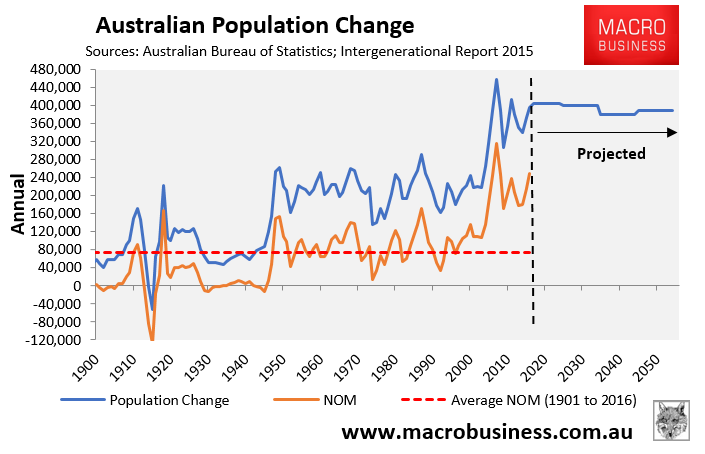Over the past several days I lambasted the ABC 7.30 Report’s three-part population special because it failed to mention the policy option of reducing immigration, instead presenting a ‘Big Australia’ as inevitable and maybe even desirable. It was reported as if we have no choice in the matter, so we must get used to it.
However, in Leigh Sales’ follow-up interview with Population Minister Alan Tudge, Sales asked the obvious question of why immigration shouldn’t be cut given the chronic problems it is creating in the big cities:
ALAN TUDGE: We evaluate that [the immigration intake] every year as part of the budget context, but one of the things I have foreshadowed is we do need a better population planning mechanism, whereby we better marry the population ambitions of the cities and the regions with the infrastructure and services, because one of the features of our federation is that we have the main population levers — be it migration and other levers — yet the states are largely responsible for the infrastructure and the services on the ground.
We need to better match those things so we can control the population growth, and that’s been my overall message.
LEIGH SALES: Well, on that point, you know, as we’ve heard over the past three nights for people in Brisbane, Melbourne and Sydney, there are constant complaints about overcrowding, about congestion, about housing. Why shouldn’t the Federal Government put a pause on immigration so the states can catch up with infrastructure?
ALAN TUDGE: Because in essence, there’s two issues going on here rather than one.
The first issue is indeed that our three big cities are growing very fast. Melbourne is growing the fastest at 2.7 per cent per annum, Sydney by 2.1, South East Queensland by about 2.3 per cent. Fast by international standards.
On the other hand, the second problem, though, is you have some regions and some smaller states who are crying out for more people.
Indeed, the regional institute of Australia reported this week that there are 47,000 vacancies in the regions alone as we speak. So if we can just ease the pressure on the big cities and enable the further growth in those jobs to be filled in the regions, then we actually achieve two objectives rather than one.
LEIGH SALES: But as we heard in that story, we’ve been trying for 100 years to decentralise Australia. You yourself say that the program you’ve been wanting to extend has been in place for a while and it hasn’t worked.
ALAN TUDGE: Oh, well, I think it has worked, but it’s been on a relatively small scale. One of—
LEIGH SALES: If you talk to people in Sydney, Melbourne and Brisbane, they wouldn’t agree with you.
ALAN TUDGE: But it’s been on a relatively small scale, and I suppose what I’m saying is that I understand the pressures which people in Melbourne, Sydney and Brisbane feel…
Thankfully somebody at The ABC – Leigh Sales – possesses common sense and is not afraid to raise the most obvious solution.
Sadly, Alan Tudge’s response was pathetic. The evidence shows that the existing regional migration schemes have been systemically rorted with the overwhelming majority of these migrants ending up in Sydney and Melbourne.
In fact, 94% of migrants last financial year settled in the cities, whereas 86% of ‘skilled’ migrants settled in Sydney and Melbourne alone. Thus, in addition to running at triple the historical average, Australia’s immigration intake has become more centralised than ever, contrary to the claimed success of the existing regional migration schemes.
In fact, Alan Tudge admitted these problems in his speech last week to the Menzies Research Centre:
Our nation is adding a city the size of Canberra every year and the size of Adelaide every 3.5 years… In absolute terms, we grew by 3.75 million people [last decade] which is nearly twice as many as in the previous decade.
…the greatest challenge is the pressure it puts on our big cities in the form of congestion. This is a serious problem in Melbourne, Sydney and South East Queensland particularly… The Bureau of Infrastructure, Transport and Regional Economics estimates the costs of congestion in Australia’s capital cities to be $25 billion a year in 2017/18 rising to $40 billion a year by 2030. This is a serious challenge for families and a serious economic challenge for the nation…
This challenge is exacerbated by the fact that 75 per cent of the population growth has been to our three largest population areas: Melbourne, Sydney and South East Queensland.
While the overall population of Australia has been growing at the rapid rate of 1.6 per cent per annum, our three large population centres have been some of the fastest growing cities in the world. Melbourne last year grew by 2.7 per cent, Sydney by 2.1 per cent and South East Queensland by 2.3 per cent…
The fact is that 87 per cent of all skilled migrants are going to Sydney and Melbourne, and nearly all of the humanitarian intake.
…the growth rate for our nation (and particularly our big cities) was well above projections. For example, the 2002 Intergenerational Report predicted Australia would grow by about 2.5 million over the last 15 years. We actually grew by 5 million.
It’s a pipe dream to believe that the Coalition’s ‘migrants to the bush’ policy will work when existing smaller schemes have failed so dismally. Instead of deploying policy smokescreens, the Coalition needs to deal with the problem at its source and reduce immigration back to more manageable historical levels:


